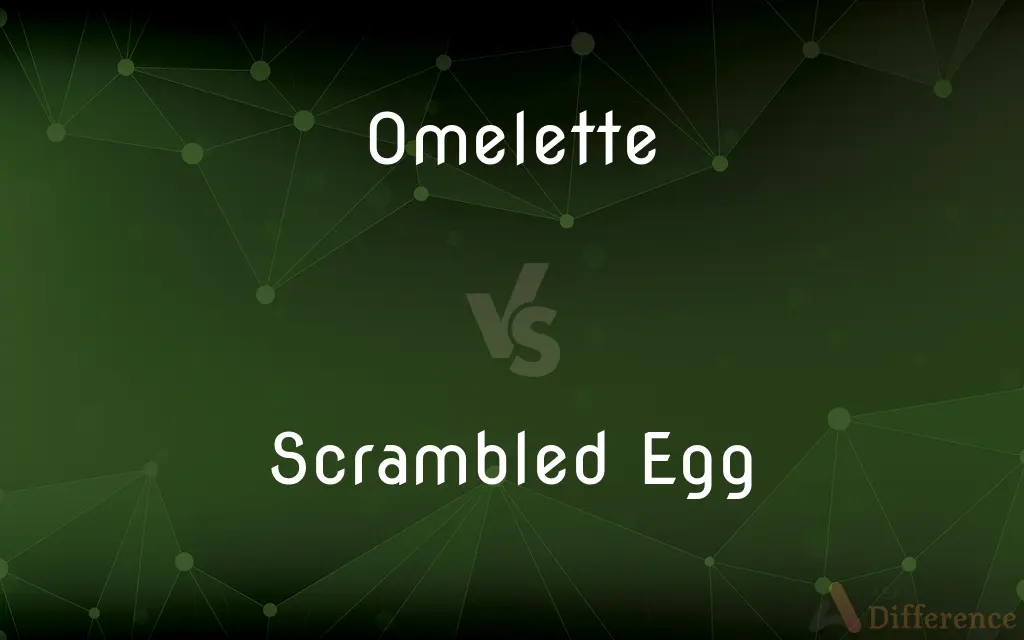Omelette vs. Scrambled Egg — What's the Difference?
By Tayyaba Rehman — Published on November 22, 2023
An Omelette is a beaten egg mixture, often with fillings, folded and cooked; Scrambled Egg is a stirred and cooked beaten egg mixture.

Difference Between Omelette and Scrambled Egg
Table of Contents
ADVERTISEMENT
Key Differences
An Omelette is a popular breakfast dish made by beating eggs, pouring them into a hot pan, and then cooking until they're set. Fillings like cheese, vegetables, and meats can be added to enhance flavor. Scrambled Egg, on the other hand, is made by continuously stirring beaten eggs in a pan until they form soft, creamy curds.
Omelettes have a more structured form, often appearing as a semi-circular or folded dish, showcasing its fillings. Scrambled Eggs lack this defined shape, appearing more as a jumble of soft egg curds, and they typically don't have the fillings that Omelettes do, although toppings can be added.
The cooking techniques between an Omelette and Scrambled Egg differ. For Omelettes, the beaten eggs are poured into a pan and left relatively undisturbed until nearly set, then folded or flipped. In contrast, Scrambled Eggs require continuous stirring to achieve their characteristic texture.
While both Omelettes and Scrambled Eggs originate from the same main ingredient—beaten eggs—their preparation and presentation differ significantly. An Omelette provides an opportunity to incorporate various fillings, creating a filled egg dish, whereas Scrambled Eggs focus on the texture of the eggs themselves.
Comparison Chart
Basic Definition
A folded egg dish with fillings.
Stirred and cooked beaten eggs.
ADVERTISEMENT
Texture
Typically smoother with a defined shape.
Soft and creamy curds.
Fillings/Toppings
Fillings are often inside the fold.
Toppings can be added but not usually mixed in.
Cooking Technique
Poured and left undisturbed, then folded or flipped.
Continuously stirred while cooking.
Presentation
Semi-circular or folded appearance.
Loose, jumbled curds.
Compare with Definitions
Omelette
Omelette is a dish made of beaten eggs cooked in a pan until set.
I made an Omelette with spinach and feta this morning.
Scrambled Egg
Scrambled Egg refers to beaten eggs cooked to a soft consistency in a pan.
Toast and Scrambled Egg make a simple yet satisfying breakfast.
Omelette
Omelette is a culinary preparation where eggs envelope various fillings.
The menu boasts a range of Omelettes, from classic to gourmet.
Scrambled Egg
Scrambled Egg is a dish of eggs stirred while cooking to form curds.
I prefer my Scrambled Egg with a touch of cream for richness.
Omelette
Omelette is a dish where whisked eggs are poured, cooked, and folded around ingredients.
The diner is known for its large, fluffy Omelettes.
Scrambled Egg
Scrambled Egg is a preparation of eggs stirred frequently during cooking.
The secret to creamy Scrambled Egg is low heat and constant stirring.
Omelette
Omelette is a beaten egg mixture that's cooked without stirring until set.
For brunch, I often choose a mushroom and cheddar Omelette.
Scrambled Egg
Scrambled Egg is a dish where eggs are cooked until they form soft, broken curds.
Add some chives to your Scrambled Egg for a pop of flavor.
Omelette
Omelette is a folded egg preparation often containing fillings.
The chef's special Omelette features sun-dried tomatoes and goat cheese.
Scrambled Egg
Scrambled Egg is a method of cooking beaten eggs to a custard-like consistency.
I like to top my Scrambled Egg with grated cheese and black pepper.
Omelette
A dish consisting of beaten eggs cooked until set and folded over, often around a filling.
Omelette
A dish made with beaten eggs cooked in a frying pan without stirring, flipped over to cook on both sides, and sometimes filled or topped with cheese, chives or other foodstuffs.
Omelette
(computing) A form of shellcode that searches the address space for multiple small blocks of data ("eggs") and recombines them into a larger block to be executed.
Omelette
Beaten eggs or an egg mixture cooked until just set; may be folded around e.g. ham or cheese or jelly
Common Curiosities
Can I add milk to my Omelette?
Yes, adding milk or cream to an Omelette can make it fluffier.
What is an Omelette?
An Omelette is a dish made from beaten eggs cooked in a pan, often filled with ingredients like cheese, vegetables, or meat.
How can I make my Scrambled Eggs creamy?
Cook them on low heat and stir continuously, you can also add cream or milk for added richness.
How do Scrambled Eggs differ from Omelettes?
Scrambled Eggs are stirred continuously while cooking to form curds, while Omelettes are left relatively undisturbed and folded around fillings.
Can I add vegetables to Scrambled Eggs?
Yes, vegetables can be added to Scrambled Eggs, but they are typically considered toppings rather than fillings.
Do I need to flip an Omelette?
Not always, some Omelettes are simply folded, while others might be flipped for even cooking.
Are Omelettes usually filled?
Yes, Omelettes often contain fillings like cheese, meat, or vegetables, but they can also be plain.
What's the difference in cooking time between an Omelette and Scrambled Egg?
Omelettes often take slightly longer due to their thickness and fillings, while Scrambled Eggs cook quickly due to constant stirring.
What's a French-style Scrambled Egg?
It's a method where eggs are cooked very slowly, often with butter, to achieve a creamy, almost custard-like consistency.
What's the key to a fluffy Omelette?
Whisking the eggs thoroughly and adding a splash of milk can help achieve a fluffy Omelette.
Can I use the same pan for both Omelette and Scrambled Egg?
Yes, a non-stick skillet works well for both dishes.
How many eggs are typically in an Omelette?
It varies, but a standard Omelette often uses 2-3 eggs.
Do Scrambled Eggs need any added fats?
A small amount of butter or oil can help prevent sticking and adds flavor.
Can I add herbs to my Omelette?
Absolutely, herbs like chives, parsley, or cilantro can enhance the flavor of an Omelette.
Share Your Discovery

Previous Comparison
Skimmed Milk vs. Double Toned Milk
Next Comparison
Mass Percent vs. Percent CompositionAuthor Spotlight
Written by
Tayyaba RehmanTayyaba Rehman is a distinguished writer, currently serving as a primary contributor to askdifference.com. As a researcher in semantics and etymology, Tayyaba's passion for the complexity of languages and their distinctions has found a perfect home on the platform. Tayyaba delves into the intricacies of language, distinguishing between commonly confused words and phrases, thereby providing clarity for readers worldwide.












































